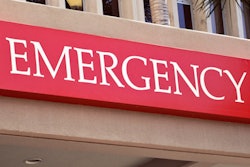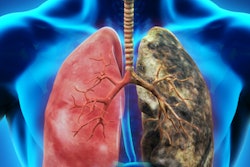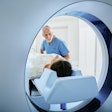
A radiology audit service in Moscow that already assesses 150 CT, MRI, and mammography systems across 64 outpatient departments is gearing up for further expansion. Unified Radiological Information Service (URIS) is expected to reduce costs for -- and sharpen competition between -- radiology departments. Furthermore, it is now focusing its efforts on honing dose analysis.
The service is currently used by 140 radiologists and 236 technicians, and it is the product of a 12-month research and development phase that resulted in an initial project connecting the outpatient departments of several Moscow hospitals in 2015. In 2016, the company added peer-review modules to its package, culminating last year in a full-scale service rollout for assessment and teaching purposes.
To date, the service has assessed nearly a million imaging studies, and 55 more imaging centers, including inpatient departments, are scheduled to join in 2019. These 55 centers represent a further 288 units, 290 radiologists, and 543 technicians, according to the developer, the state research institution called Research and Practical Center of Medical Radiology (RR & PC), Department of Health Care of Moscow.
URIS provides a software interface for communication with its experts and a screen dashboard developed in 2017 for ongoing auditing and assessment. Different software packages are available for institutional subscription, and prices are fixed per CT, MRI, and mammography exam. The Russian government currently reimburses state hospitals' access to URIS, but the service is also available to private institutes, though none have yet fully subscribed.
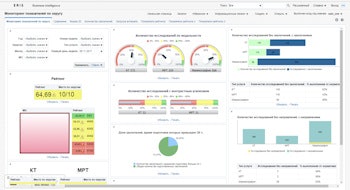
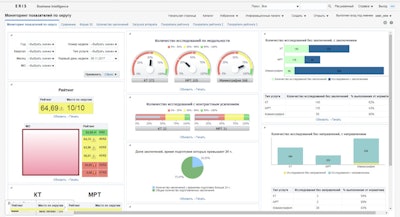
The Oracle-based dashboard demonstrates the ratings of the radiology departments in the domains of quality and effectiveness, report turnaround times, percentage of contrast-enhanced studies, and delayed reports, according to RR & PC. All images courtesy of RR & PC.
"We wanted the service to leverage the specialty by showing metrics on an onscreen dashboard so that radiologists could clearly see referral times, reporting times, analysis and audits of the studies, and any discrepancies in referrals, image acquisition, and reporting," said Dr. Sergey Morozov, PhD, RR & PC's CEO and chief regional radiology officer for Moscow and the Central Federal District of Russia.
He added that the dashboard shows different radiology ratings to different parties: "Our work at the moment is focusing on safety, particularly departmental dose analysis -- we've had a very successful dose analysis pilot study with Belgian patient safety and quality solutions firm, Qaelum."
Through the service's Comprehensive Audit of Radiological Examinations (CARE) software, up to 10% of daily studies are analyzed by 25 URIS radiology and radiography experts across different institutes. They evaluate the images and report quality using quantitative indicators such as patient placement, slice positioning, report structure, lesion description, diagnosis, terminology, and recommendations. Then they flag any technical, procedural, or interpretative discrepancies.
The service aims to identify discrepancies that may affect the treatment and also provide up-to-date, evidence-based recommendations and training programs, according to Morozov. Meanwhile, ongoing assessment of machine performance can check for any technical faults or upcoming maintenance required.
The service, which supports real-time monitoring for quality and discrepancies, has far-reaching implications for improving practice and safeguarding patients, he added. Morozov also pointed to how such performance monitoring can help institutes increase reporting activity -- and reduce payrolls: In a pilot study at five subsidiary outpatient polyclinics using URIS, one polyclinic revealed a fourfold throughput increase, with radiologists reporting an average of 21 studies per shift, up from five studies per shift.
"Monitoring has allowed the clinics to see who were its most reliable and productive radiologists and transfer the others -- outgoings were thus reduced by 38%," he said. "Such competition between radiologists and institutes is a means for all parties to up their game. The top 10 radiologists and departments can be seen publicly, while radiologists who perform less well are informed of any discrepancies and can visualize their rating privately."
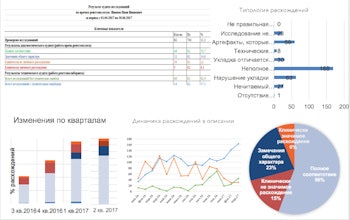
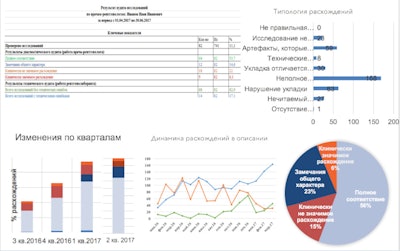
Monitoring professional performance promotes friendly competition between institutes, according to RR & PC. The interface pictured here shows the numbers of discrepancies across four categories, types of technical discrepancies, and quarterly and monthly dynamics. The report is extracted from CARE's peer-review system, distributed to department chiefs, and used for the planning of webinars and CME teaching sessions.
Six months ago RR & PC added a low-dose CT lung cancer screening audit program to CARE that is being implemented by 10 hospitals. The company hopes 50 more departments will subscribe in 2018. This specific audit component ensures that screening exams fall in line with strict Russian legislation that stipulates annual effective dose for screening should not exceed 1 mSv.
"The goal is to have full Moscow coverage through 60 screening centers. The system provides user interface, lesion measurement, and reporting tools, and because there is a relatively high error rate, 70% of lung cancer screening studies are peer reviewed through our service," said Morozov, a radiologist who also specializes in public health. "Of 5,300 patients screened over the past six months, 150 Lung-RADS 4 lesions -- suspected lung cancer cases -- have been detected by centers using CARE."
Over the next few years, RR & PC aims to research the possibility of connecting more modalities to its service, including x-ray and ultrasound, and expanding its specialists' accreditation services and online teaching modules on MRI, CT, and ultrasound basics. Last year, these modules were accessed by 16,000 imaging staff across Russia and neighboring countries such as Armenia, Belorussia, Kazakhstan, and Ukraine.





